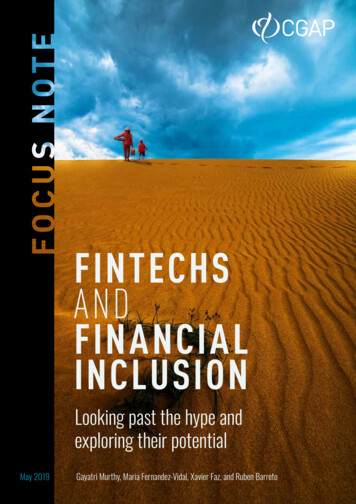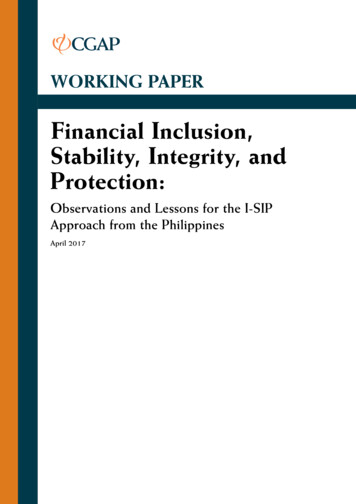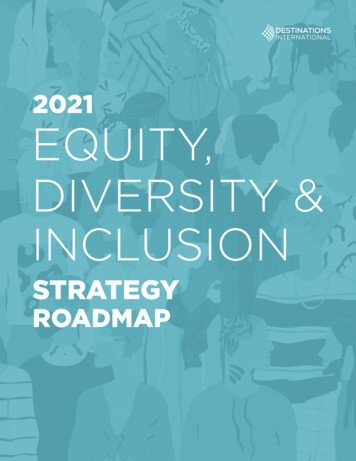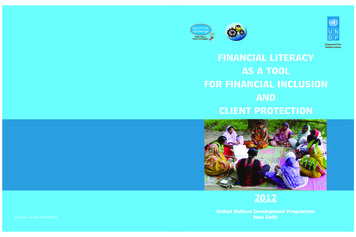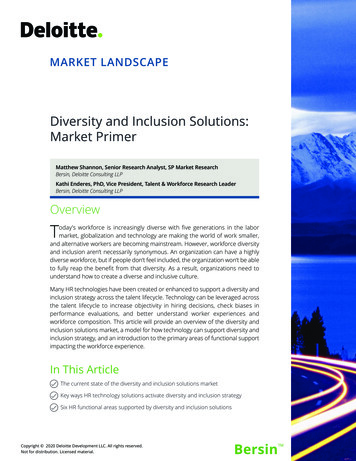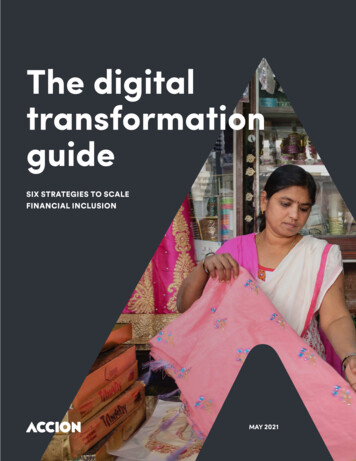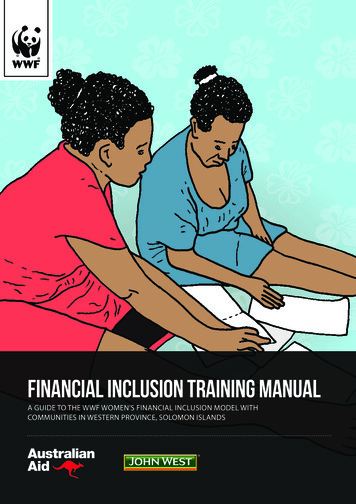
Transcription
FINANCIAL INCLUSION TRAINING MANUALA GUIDE TO THE WWF WOMEN’S FINANCIAL INCLUSION MODEL WITHCOMMUNITIES IN WESTERN PROVINCE, SOLOMON ISLANDS
OUR VISION:The people of Solomon Islands managing their natural resources for food security,livelihoods and a sustainable environment.“ Olketa pipol lo Solomon Islands lukaotim gud olketa samting loland an sea fo kaikai, wokim seleni, an gudfala place fo stap. ”PUBLISHED BY:WWF-Pacific (Solomon Islands) P.O.Box 1373,Honiara Hotel SOLOMON ISLANDSTEL: 677 28023EMAIL: sseeto@wwfpacific.orgJune 2018Any reproduction in full or in part of this publication must mention the title andcredit the above-mentioned publisher as the copyright owner. All rights reserved.Written by Nicole LowreyDesign and graphics by Toli WanefaleaEdited by Dr Alice Aruhe’eta PollardPhotos by WWF Solomon Islands, Gizo Office, and Nicole LowreySpecial thanks to Dr Alice Aruhe’eta Pollard, and WWF staff Shannon Seeto, SalomeTopo, and Dafisha Aleziru for providing information and guidance for the report.For additional information, or if you would like to donate, pleasesend an email to Shannon Seeto to at WWF-Pacific (Solomon Islands):sseeto@wwfpacific.orgThis publication has been funded by the Australian Government through the AustralianNGO Cooperation Program (ANCP) and John West Australia. The views expressed in thispublication are the author’s alone and are not necessarily the views of the AustralianGovernment or John West Australia.
INTRODUCTIONDr Alice Aruhe’eta Pollard started her financial inclusion model in Solomon Islands with the West 'Are'AreRokotanikeni Association (WARA) in 2006 to empower women in the rural areas for development and helpthem reach gender equality. In 2013, Dr Pollard discussed the WARA model with WWF and women in WesternProvince, and how it could work for them, noting good cash flow in the Gizo and surrounding communities.The WARA model (Balancing Model) was then adapted to fit the women and communities WWF works with.The WWF financial inclusion work is a component of the Sustainable and Resilient Island CommunitiesProgramme. This programme supports island communities to manage their forests, reef and fish resources, andprovides alternative livelihood opportunities, away from the reef or land, to women through financial inclusiontraining and savings clubs.A key difference between the financial inclusion model built by WWF and Dr Alice Pollard and otherorganisations is its strong focus on the environment and social impacts. Communities that sign up tofinancial inclusion with WWF must follow sustainability criteria when taking out loans and starting businesses,to ensure that any business or development opportunities do not harm the environment or have negativeimpacts on the community. As many small businesses in remote communities make money from thenatural resources in the environment, it is important for communities to ensure their usage is sustainable, sobusinesses can be sustained and thrive for years to come.WWF has trained local women in financial inclusion and these women can be invited by any interestedcommunities to conduct awareness training and establish savings groups. With the increasing demand forfinancial inclusion programs coming in from various groups in and around Gizo communities, it is fitting thatWWF engages in capacity building with local women in financial inclusion which is sustainable and accessible.This manual is designed to help trainers facilitate financial inclusion training workshops with interestedmembers in their communities, and to help communities establish and operate their own savings clubs.It is designed as a guide for training sessions, to be used alongside other training materials. The manualcan also be used by government agencies, Non-Government Organisations (NGOS), and CommunityBased Organisations (CBOs) as a guide for how financial inclusion has worked in practice in remote islandcommunities in Western Province.While WWF’s financial inclusion model has been designed specifically for women, to empower them and buildtheir financial and business capacity, a similar model can be developed for both men and women by usingthis manual as a guide. There are other models that are available and used by other NGOs working in SolomonIslands such as the World Vision model.
ESTABLISHING AND RUNNING SAVINGS CLUBSThere are multiple stages to starting savings clubs, and ensuring they run long-term for the benefit ofall members and are sustainable. The first stage is community awareness and consultations on financialinclusion, and then a community invitation. From there, financial literacy training can be conductedto engage the groups perspective and their level of understanding and commitment to organise andlead such an initiative. Having identified the strength of the group in terms of leadership, literacy andcommitment, a savings club can be established. Over time and based on proven financial record of thegroup, a loan component could be established in parallel with the savings. Sustainability, accountabilityand transparency criteria can be introduced with additional training in loans, calculations, interest andloan repayments. Simple addition/subtraction, balancing, clear recording and writing are crucial insavings. Annual Action Audits occur to ensure accounts are all up to date and money is being correctlyrecorded and balanced. These processes should be transparent with all members. Stages include:Community awarenesson financial inclusion1.The community must discuss iffinancial inclusion is somethingthey are interested in, in additionto sustainable fisheries training.Financial literacy training3.5.7.» Business plan template training» Business and management trainingLoan componentestablishedBalance andAction AuditsShareknowledgeMembers can share the benefitswith other communities, andhow they can become involved.» Leadership training.46.8.Monitoring of the movement ofmoney to ensure correct processesand procedures are followed.9.If requested, this can include:4.During the training, the loancomponent is established(after fundraising for theRevolving Fund) and memberscan start to take out loans.Savings club members must followsustainability criteria if they takeout a loan.AdditionaltrainingSavings clubestablishedDuring financial literacytraining, a committee isorganised and the savingsclub is established.This training discusses administrationand can be held straight afterfinancial literacy training. It alsointroduces what loans are, and whybusinesses need to be sustainable.Sustainabilitycriteria introduced2.Once community agreement isreached, an invitation can be sentto WWF for support and training.The first training provided to teachwomen what savings are, how to setgoals and budgets, and how to reachthem.Microfinance, administration,loan and sustainability trainingCommunity expression ofinterest / invitation to startthe savings clubFinancial Inclusion Training Manual Published by: WWF-Pacific (Solomon Islands) JUNE 201810.
HOW A SAVINGS CLUB WORKSA savings club is an informal financial group, where members save money and aim to achievea short, medium or long-term goal. Savings clubs can also help by providing loans to membersthrough the loan scheme, but only some savings clubs allow this. Women’s savings clubsencourage women members, female children to join. This assists women to provide leadershipand make decisions about money. In addition, families, tribes or communities can organise theirsavings group that may be inclusive of both genders.In the WARA/WWF model, women’s savings clubs have three types of funds; Savings Fundsfrom the individual women's savings, a Revolving Fund which includes money working throughthe hands of women in the community through a small-loan component, and an OperationsFund that supports the administration of the savings club. The money comes from financialmembership fees, fundraising from the group, or donation from donors. WWF encouragessavings clubs to fundraise for the Operations Fund to support natural resource management and/or enforcement, as many small businesses depend on natural resources in the environment beingsustainably managed. Each savings club will also raise 1,000 as an annual contribution to thePeer-to-Peer Network for Women’s Savings Clubs to help support management of communityfisheries and resources. Extra funds can also be raised for community-wide needs with a positiveenvironment or social impact, if all executive agree.To participate in women’s savings clubs, a woman must attend Financial Literacy training first andpurchase a Savings Club Passbook. She must also be a financial member of the club throughpaying a small membership fee. Through training, women are encouraged to save their money,learn to budget for themselves and their family, discuss savings and what it means with theirhusbands and partners, and to think about beginning small-scale business opportunities throughthe small-loan component. To ensure any new businesses are in line with WWF’s conservationand environmental goals, sustainability criteria for loans have been developed that must bemet before a loan is granted to an individual. Ongoing monitoring of the club is done throughthe committees and a Balance and Action Audit with WWF and local women trainers twice a year.Financial Inclusion Training Manual Published by: WWF-Pacific (Solomon Islands) JUNE 20185
BEFORE TRAINING STARTSCommunities must express their interest and talk to WWF about the financial inclusion processfirst. WWF’s financial inclusion work is part of the Sustainable and Resilient Island Communitiesprogramme and linked to sustainable fisheries co-management work.If communities are still interested, they must write a letter to WWF asking for trainingand support. Interested communities must introduce the sustainable fisheries programme beforethey can receive financial inclusion training.Once a letter is received, WWF organises a time to visit the community and conduct training. Thecommunity then has to talk to the women and see how many are interested in joining a savings club,and to write down the names of women who want to be in the savings club committee and whatroles each of them will take. This is important as the work involved requires commitment, disciplineand trustworthiness. It is also voluntary and involves huge personal costs. Positions and roles of theexecutive include:Roles include:» President – leader and manager of the savings club group» Vice-President – second in charge» Treasurer – responsible for storing and accounting for the money» Vice Treasurer – responsible for storing and accounting for the money» Secretary – responsible for recording minutes and organising meetings» Assistant Secretary – responsible for recording minutes and organising meetings» Money Counters x 3 – collect and count the money on Bank Day and recordit against the passbook, individual record book and the zone record book.6Financial Inclusion Training Manual Published by: WWF-Pacific (Solomon Islands) JUNE 2018
FINANCIAL LITERACY TRAINING – 3 DAYSWhat: Financial Literacy training teaches women the value of money, what saving is, andhow to save and use money. The savings club is established, as well as the committee. GoodGovernance training teaches women their key roles and responsibilities.When: This training is given once the community has invited WWF to train them, andis mandatory for all women who wish to join the savings club. If more women requestto join the club, the training may be given to new members.DAY 1: FINANCIAL LITERACY TRAININGTo start, the trainer has to discuss the goals of the workshop to participants. Howto manage money (personal savings and collective savings schemes), what savings groupswill involve, challenges, achievements and the function of the established savings club group.The trainer splits the women into small groups according to the number of women presentand gives them paper and pens. Then the trainer discusses how women get money and usemoney, for themselves or for their family, and where it goes. This includes understandingmoney.Activity 1: Personal SavingsThe trainer asks the group:» 1. List what ways women earn money.» 2. List what ways women spend money.» 3. Write down who you currently owe money to.» 4. Write down who currently owes you money.As a group a list is recorded of all the ways women can earn money, and a list of howwomen spend money. This activity shows that there are many opportunities to makemoney, but just as many ways to spend. It is important to understand that money flows. Itis important to save little by little to see your money grow. If you save, they will add up to alarge amount.Main messages: How long does it take you to earn money compared to how long ittakes you to spend? Money should not control us; we should be the boss of our money.Activity 2: Needs vs. WantsMost important things versus less important things. The trainer divides participants intosmall groups and asks them to:» List the things you really need to buy.» List the things that you want, but don’t really need.» List the things that can wait until you have enough funds.A woman from each group reads their answers. The outcome of the activity is to makewomen think about what they need to spend money on, and identify those things thatwomen can reconsider buying. This activity is very important for participantsto understand that they have limited money and to use their small earnings wisely,and to prioritise what are important items for the limited money they have.Main Messages: Think and ask yourself before you buy things. Some things can waituntil you have enough money to buy them. Self-control and discipline are very important.Financial Inclusion Training Manual Published by: WWF-Pacific (Solomon Islands) JUNE 20187
Goal SettingThe trainer will discuss how to set a goal, like an aim or target, to help manage money. Explaingoals are important so we can stay focused, help us work hard, give us a targetto work to and help us save money. To set your goal, be specific, and list the benefitsof reaching your goal.Activity 3: Set a GoalTimeframes are important to help reach goals. The trainer asks each woman to set a goal in theirIndividual Record Book. If they have a goal, they need to know the estimated price of the itemthey want to buy, for how long they would save, and how much in a week, month or yearto save before achieving that goal. This section is very important as women can calculate theamount that they could save daily, weekly, monthly or yearly. Goal setting refers to SMART goals.These initials stands for Specific, Measurable, Achievable, Realistic and Time bound.The SMART goal concept can help women to set realistic goals.» S Specific» M Measurable» A Achievable» R Realistic» T earsAmountto savepermonthAmountto saveper yearGoal typeBuy solarset 2,28024months2 year 95 1,140MediumTerm*Timeframes:» Short Term 0-6 months» Medium Term 7 months – 1 year» Long Term 1 year Volunteers can present their goal back to the big group. Main messages: keep saving, anddon’t set more than one goal at once. If you fail, don’t worry. Review your plan and set a newplan.8Financial Inclusion Training Manual Published by: WWF-Pacific (Solomon Islands) JUNE 2018
BudgetingA budget is a plan on how to save and spend money. It can be daily, weekly, monthlyor yearly. Budgets include the sources of funds, and the outflow of funds.DateIncomeSpendingSavings(income minusspending)BalanceMondayNilNilNilNilTuesday Market Day 100 - soldtomatoesand lettuce 100- 20 80 80 80- 30 50 50 50- 10 40 40 140 – 10 130 130 125WednesdayNilSoap 5Betelnut 5Food 10Mobile Topup 20Betelnut 5Food 5Kerosene 5ThursdayNilFriday 100 –sellingvegetablesBetelnut 5SaturdayNilChurch 5 130 - 5 125SundayNilBetel Nut 5 125 - 15 110MondayNilBetelnut 5Food 5Food 10Betel Nut 5 110 - 5 105 110 105When budgeting, try to live within your budget and discipline yourself. Carry a notebook to recordeverything that goes in and out, and spread money across storage bottles for different things (e.g.weddings/funerals, transport, school fees)Activity 4: Set a BudgetThe trainer will ask each woman to write a budget for what you have spent money forlast week, using the same table as above. Once finished, write up a budget for next week. Volunteerswill be asked to share to the big group. This is a very important part of the training to teachparticipants how to do budgeting daily, weekly, monthly and yearly. There are budget techniquesthat can be taught to participants on how to do budgeting at home.Financial Inclusion Training Manual Published by: WWF-Pacific (Solomon Islands) JUNE 20189
DAY 2: ELECTION OF THE ZONEMANAGEMENT COMMITTEEOn the second day of Financial Literacy training, the community agrees the roles andresponsibilities of the committee and who will take what roles.The President’s role is to host the Annual General Meeting, all general meetings andexecutive meetings, and oversee the administration, operation and financial matters ofthe club. The Vice President takes the role of the President in her absence, or when delegated to.The Treasurer and Vice Treasurer keep records of all financial transactions, store bankmoney and receipts, and prepare financial reports for the Annual General Meeting.They look for any financial inconsistencies and report them to the President, andkeep registers of small businesses and loans that have been started.The Secretary and Vice Secretary attend all meetings, keep minutes, files and reports,and keep an up-to-date membership register. They are also responsible for organisingmeetings and agendas.Money Counters are responsible for collecting the money women save during the Bank Day,and record the money into the Savings Passbook, Individual Record Book and the ZoneRecord Book. At the end of the bank day, they have to count the money and make sureit reconciles and balances with the record in the Tally Sheet. They are responsiblefor administering and managing members’ savings.Once women have been allocated to each of the roles, the committee is then established,and the first bank day starts for women to deposit their savings. The trainer helps theMoney Counters to record the money.Savings Schemes in Solomon islands – Four savings Models:The trainer discusses four well-known models of savings clubs in the Pacific andSolomon Islands, to show that it is not a new idea and women have been savingthrough different methods around the Pacific. They include the:1. Live and Learn model2. World Vision model3. Vanwood model (Vanuatu)4. Rokatanikeni model (West Are’ Are’)The Rokotanikeni Model (West Are’ Are’) is the model that WWF has adaptedfor communities in Western Province. There are three types of funds:1. Savings Fund – this is where a women saves her money.2. Revolving Fund – this is where the loan money comes from. The moneyto start the revolving fund can be from donors, donation from supporters,or from fundraising.3. Operations Fund – this is where administration costs come from. Each zonefundraises for this fund for operation costs of their savings club to cover costsof transportation for meetings, stationary, etc.10Financial Inclusion Training Manual Published by: WWF-Pacific (Solomon Islands) JUNE 2018
Activity 5: Coordinating Zones and Money Counter TrainingSavings clubs are established according to zones, and members are allocated to a zone.This is usually based on community groups. In this activity, the trainer divides groupmembers according to their zones and each group has to come up with a name of theirsavings club. The three selected Money Counters come to the table with the trainersand learn how to record and manage the savings deposits from members. Each memberis required to buy a Savings Passbook and Money Counters allocate each member witha member account number.Each woman receives a member number as 01 for the first registered member, then 02, 03,04, etc. Then the year the member joins is added, i.e. 18 for a member who joined in 2018.For example, Gizo Environment Livelihood Conservation Women’s Savings Club (GELCWSC)allocates their members number as follows:GEL: stands for GELCWSCZ1: Zone 1 (depending on what zone you are in e.g. Zone 2 would be Z2)01: The first register member, the next would be 02, 03, 04 etc.18: The year the member joined e.g 2018The first member number will look like – GELZ10118Each zone is given two ledger books. The first is named the Individual Deposit andWithdrawal Record Book. The first page of the book is left for recording membernumber and name in two columns.Financial Inclusion Training Manual Published by: WWF-Pacific (Solomon Islands) JUNE 201811
1. Filling in the Savings PassbookEach woman buys a Savings Passbook when they join a savings club, and will add her realname into it. On each Bank Day the money counters must fill in the passbook with thedate, how much you are putting into the club to save, how much you are withdrawing, andthe balance. The two Money Counters will then co-sign it and you keep the passbook withyou until the next Bank Day.Example Savings Passbook:DatePaid in 5/10/17508/11/17Withdrawn Balance MoneyCounter 1MoneyCounter K16/1/182000035000SLJK1/2/20181000045000SLJKAs you can see, each year the record balance is brought forward for New Year. After each year’srecord, give breathing space for easy audit and balancing. Leave a space between each yearto make it easy for someone outside to check the recording and balance the books.2. Filling in the Individual Record BookWhile every woman has their Savings Passbook, the savings club has an Individual RecordBook. This is kept by the Money Counter. The recording in the Individual Record Book issimilar as the Savings Passbook, but it keeps all members individual deposit or withdrawalrecords together in a book. The Money Counters have to make sure that each individualmember has her own page to record the woman’s name, account number, moneydeposited, withdrawn, and the balance. After four pages, the Money Counter records thenext Bank Day with the member’s name, account number, money deposited, withdrawnand total balance, etc. This book must always reconcile with the Savings Passbook, afterit is signed by two Money Counters.12Financial Inclusion Training Manual Published by: WWF-Pacific (Solomon Islands) JUNE 2018
Example Individual Record Book:Name: Brenda KanikiAccount No:GELZ50113DateDeposit Withdraw Balance Money Counters 1& 2 000045000StellaJulieSimilarly to the recording in the Savings Passbook, give breathing space between the yearsso that it makes audit check easier and clearer. Both Money Counters must sign this record.3. The Zone Record Book (Group Record Book)The money counter also records all money deposited by women that banking day into aZone Record Book. This records the banking that was done that day. The Money Counterkeeps the women’s money in a box with a lock and key. The key is kept by three differentwomen chosen by the members of the savings club.Money Counters must also fill in the Zone Record Book at the end of each Bank Day. This isto show the records of each woman who banked on that day. The Money Counter will fill inthe date, women’s names and account numbers. Then they write the amount each womandeposited or withdrew, and the member will sign the book. The two money counters signthe transaction and the zone running collection is tallied, as well as the zone runningbalance. A spare line is left between each bank day.Example zone record book:DateNamesAccount No:Deposit5/10/17Brenda KanikiGELZ501135/10/17Glady’sFationa5/10/17Jane 2ZonerunningCollection 00JaneSLJK170TotalCollected1708/11/17Brenda ionaGELZ50813200GladysSLJK3008/11/17Jane SuGELZ51013250JaneSLJK5508/11/17Anita cial Inclusion Training Manual Published by: WWF-Pacific (Solomon Islands) JUNE 2018ZoneRunningBalance 17062013
4. Tally SheetAt the end of each Bank Day, a Tally Sheet is filled in to record who banked, and toreconcile funds against the Zone Record Book. The Tally Sheets are kept by the MoneyCounters, and they make sure that the amount received from each individual memberrecorded in the Tally Sheet always reconciles with the Zone Record Book. The zonePresident does a final check-up, physically counting the money received that Bank Daybefore the Tally Sheet is signed off. The bankers can announce the total collection ofsavings that day to all members.WWF keeps a database of the overall recordings of the total money saved and withdrawnfrom each woman’s savings club, after Balance and Action Audits that are conducted twicea year in each savings club.Steps for Money Counters on Banking Day:1. Record everything in each member’s Savings Passbook2. Find member page in Individual Record Book and record their details3. Enter details into Zone Record Book (remember to cross check balanceagainst Individual Record Book member balance)4. Enter details into Tally Sheet5. At the end of Bank Day, add up total cash amount and cross check it matchesthe zone amount, then record how many notes and coins collected on the tally form6. Make sure zone President does the last check of all the recording and physicalcounting of the money received or withdrawn on this Bank Day, before signingoff the Zone Record Book and Tally SheetNote that each savings zone determines which day every week or two weeks thatthey will have a banking day. The decision will be made by the elected managementcommittee.Rules of Savings Clubs:The trainer discusses the rules of being part of the savings club. This includes:» There is no minimum deposit amount on savings.» Each zone must raise money for their savings club’s operation costs.» Members must save money first, and then wait one year before loancomponent can start» Members must attend all training.» You must trust each other, and the box holders with the money.» Executives choose a bank day for each savings club, usually once everytwo weeks on same day.» Members must respect and encourage each other to save little by little,and share skills and knowledge.14Financial Inclusion Training Manual Published by: WWF-Pacific (Solomon Islands) JUNE 2018
DAY 3: GOOD GOVERNANCE TRAININGThe trainer discusses with the group what good governance is, what administration is,and how to properly manage a savings club.What is Governance?Governance is a process of decision-making, or a system of governing an organisationor group. Good governance provides mechanisms to follow, so proper process andadministration is followed.Organisations are governed by a Board of Directors, or a committee, to direct themanagement team of an organisation or group. This group is led by the Chair. It isimportant you are careful in who you select as a Chair. They need to be someone whois a leader, thinker and a visionary, as this person is responsible to ensure the group iswell run, financially sound, and compliant with relevant rules.ADMINISTRATION, LOAN SCHEME ANDSUSTAINABILITY TRAINING - 3 DAYSWhat: To talk about administration of the savings club, including declarations,withdrawals, rules and regulations of the club. This training also sets up the revolvingfund and loan component.When: This training is conducted one year after the savings club is established, afterwomen have learned how to save and a large amount of savings has been deposited.Now they can start thinking about withdrawing money, establishing a revolving fund,and learning how to take out a loan.Day 1: Will Declaration FormThe trainer discusses the will declaration form and teaches the women how to fill outthe form. This is an important part of the process, as if a women passes away, it mightbe unclear who should inherit her money. The will declaration makes sure the moneygoes to the right person.To fill out the form, a woman must write her name, member number and zone. Thenshe can choose to nominate one person or more who will inherit her money, if shedies, and what reasons the money can be used for. The woman must then sign theform, and a witness will also sign.Withdrawing MoneyThe trainer discusses the withdrawal form and teaches the women how to fill outthe form. To withdraw money, a woman must make a request to her savings club.She must take a withdrawal request form and fill out her zone number, date, nameand passbook number. The woman will also write her reason for withdrawing themoney, and any outstanding loan she has. The woman will give the form to themoney counter to cross check against their Savings Passbook, Individual RecordBook, and Zone Record Book before sign off. The balance in the woman’s savingsis recorded before the withdrawal, and recorded after the withdrawal. Two MoneyCounters must then sign the woman’s request form. It is then signed off by the ZonePresident. You can only withdraw money three times a year, or as decided by theAdvisory Management Committee.Financial Inclusion Training Manual Published by: WWF-Pacific (Solomon Islands) JUNE 201815
AdministrationMembers learn about administration of the savings club in the Financial Literacy training.However, if women need refresher training, the trainer can arrange for another Financial Literacytraining to be held in the community. The committee can decide if refresher training is needed ornot.Revolving Fund (Loan Component)In addition to women’s individual savings, a savings club can be set up to have a revolving fund.A Revolving Fund is a loan scheme where wome
Then the trainer discusses how women get money and use money, for themselves or for their family, and where it goes. This includes understanding money. Activity 1: Personal Savings The trainer asks the group: È 1. List what ways women earn money. È 2. List what ways women spend money. È 3. Write d
